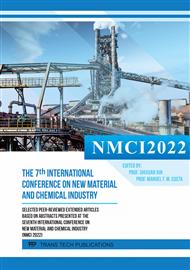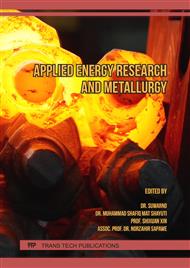[1]
A. J. Louli, A. Eldesoky, R. Weber, et al., Diagnosing and correcting anode-free cell failure via electrolyte and morphological analysis, Nat. Energy, 5(2020) 693–702.
DOI: 10.1038/s41560-020-0668-8
Google Scholar
[2]
C. Niu, D. Liu, J. A. Lochala, et al., Balancing interfacial reactions to achieve long cycle life in high- energy lithium metal batteries, Nat. Energy, 6(2021) 723–732.
DOI: 10.1038/s41560-021-00852-3
Google Scholar
[3]
L. Zhu, W. Zhu, X.-B. Cheng, et al., Cathode materials based on carbon nanotubes for high-energy-density lithium–sulfur batteries, Carbon, 75(2014)161–168.
DOI: 10.1016/j.carbon.2014.03.049
Google Scholar
[4]
A. Rosenman, E. Markevich, G. Salitra, et al., Review on Li-sulfur battery systems: an integral perspective. Adv. Energy Mater., 5 (2015) 1500212.
DOI: 10.1002/aenm.201500212
Google Scholar
[5]
M. Hagen, P. Fanz, J. Tübke, Cell energy density and electrolyte/sulfur ratio in Li–S cells. J. Power Sources, 264(2014) 30-34.
DOI: 10.1016/j.jpowsour.2014.04.018
Google Scholar
[6]
M. Hagen, D. Hanselmann, K. Ahlbrecht, et al., Lithium–sulfur cells: the gap between the state-of-the-art and the requirements for high energy battery cells. Adv. Energy Mater., 5(2015)1401986.
DOI: 10.1002/aenm.201401986
Google Scholar
[7]
S. Dörfler, H.Althues, P. Härtel, et al. Challenges and key parameters of lithium -sulfur batteries on pouch cell level, Joule, 4(2020) 539-554.
DOI: 10.1016/j.joule.2020.02.006
Google Scholar
[8]
J. G. Davis, K. P. Gierszal, P. Wang, D. Ben-Amotz, Water structural transformation at molecular hydrophobic interfaces. Nature, 491(2012) 582–585.
DOI: 10.1038/nature11570
Google Scholar
[9]
P. Ball, Water as an active constituent in cell biology. Chemical Reviews vol. 108 (2008) 74–108.
Google Scholar
[10]
Q. Du, E. Freysz, Y. R Shen, Surface vibrational spectroscopic studies of hydrogen bonding and hydrophobicity. Science, 264(1994) 826–828.
DOI: 10.1126/science.264.5160.826
Google Scholar
[11]
P. N Perera, Observation of water dangling OH bonds around dissolved nonpolar groups. Proc. Natl. Acad. Sci., 106(2009) 12230–12234.
DOI: 10.1073/pnas.0903675106
Google Scholar
[12]
L. R. Pratt, A. Pohorille, Hydrophobic effects and modeling of biophysical aqueous solution interfaces, Chem. Rev., 102(2002) 2671–2692.
DOI: 10.1021/cr000692+
Google Scholar
[13]
H. J. Peng, J. Q. Huang, X. B. Cheng, Q. Zhang. Review on high-loading and high-energy lithium–sulfur batteries[J]. Adv. Energy Mater., 7 (2017) 1700260.
DOI: 10.1002/aenm.201700260
Google Scholar
[14]
G. G. Eshetu, X. Judez, C. Li, et al. Ultrahigh performance all solid-state lithium sulfur batteries: salt anion's chemistry-induced anomalous synergistic effect. J. Am. Chem. Soc., 140 (2018) 9921–9933.
DOI: 10.1021/jacs.8b04612
Google Scholar
[15]
Q. Pang, X. Liang, C. Y. Kwok, L. F. Nazar, Advances in lithium–sulfur batteries based on multifunctional cathodes and electrolytes. Nat. Energy, 1(2016)16132.
DOI: 10.1038/nenergy.2016.132
Google Scholar
[16]
Y. He, Z. Chang, S. Wu, H. Zhou, Effective strategies for long-cycle life lithium–sulfur batteries. J. Mater. Chem. A, 6(2018) 6155-6182.
DOI: 10.1039/c8ta01115j
Google Scholar
[17]
L. Zhang, Y. Jiao, F. Wang, et al., Tailoring lithium fluoride interface for dendrite‑free lithium anode to prolong the cyclic stability of lithium-sulfur pouch cells, Nanoscale Res. Lett., 17(2022) 117.
DOI: 10.1186/s11671-022-03745-w
Google Scholar
[18]
W. Chen, Y. Hu, W. Lv, et al., Lithiophilic montmorillonite serves as lithium ion reservoir to facilitate uniform lithium deposition, Nat. Commun., 10 (2019) 4973.
DOI: 10.1038/s41467-019-12952-6
Google Scholar



